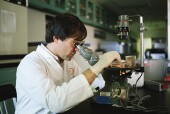- Skip Storing This Everyday Product in the Fridge Door
- Green Tea + B3 Pairing May Boost Brain Health
- Navigating Your Midlife Crisis: Embracing New Possibilities
- City Raccoons Showing Signs of Domestication
- Mapping the Exposome: Science Broadens Focus to Environmental Disease Triggers
- One Week Less on Social Media Linked to Better Mental Health
- Your Brain Changes in Stages as You Age, Study Finds
- Some Suicide Victims Show No Typical Warning Signs, Study Finds
- ByHeart Formula Faces Lawsuits After Babies Sickened With Botulism
- Switch to Vegan Diet Could Cut Your Greenhouse Gas Emissions in Half
Stem Cell Success Raises Hopes of Type 1 Diabetes Cure


In what may be a step toward a cure for type 1 diabetes, researchers say they’ve developed a large-scale method for turning human embryonic stem cells into fully functioning beta cells capable of producing insulin.
Type 1 diabetes, an autoimmune disorder affecting upwards of 3 million Americans, is characterized by the body’s destruction of its own insulin-producing pancreatic beta cells. Without insulin, which is needed to convert food into energy, blood sugar regulation is dangerously out of whack.
Currently, people with type 1 diabetes need daily insulin injections to maintain blood sugar control. But “insulin injections don’t cure the disease,” said study co-author Douglas Melton, of Harvard University. Patients are vulnerable to metabolic swings that can bring about serious complications, including blindness and limb loss, he said at a teleconference this week.
“We wanted to replace insulin injections using nature’s own solution, being the pancreatic beta cell,” Melton said. Now, “we are reporting the ability to make hundreds of millions of these cells,” he added.
Melton ultimately envisions a credit card-sized package of beta cells that can be safely transplanted into a diabetes patient and left in place for a year or more, before needing to be replaced.
But between then and now, human trials must be launched, a venture Melton thinks could begin in about three years.
If that research pans out, the Harvard team’s results may prove to be a benchmark in the multi-decade effort to deliver on the promise of stem cell research as a way to access new treatments for all sorts of diseases.
Melton, co-director of the Stem Cell Institute at Harvard, described his work as a “personal quest,” given that he has two children with type 1 diabetes.
He and his colleagues outlined the recent results in the Oct. 9 issue of Cell.
Stem cells are essentially undifferentiated cells that can be induced into becoming specialized cells that are tissue- or organ-specific, according to the U.S. National Institutes of Health.
In some cases, such cells are sourced from embryonic tissue. Alternatively, it’s possible to derive stem cells from prespecialized adult cells that are then reprogrammed to morph into an undifferentiated state. These are called induced pluripotent stem cells.
Because the current effort was launched before the innovation of induced pluripotent stem cells, Melton said his team conducted its work using embryonic stem cells. Nevertheless, he said the newfound ability to generate large supplies of beta cells will work using either type.
People without diabetes have an average of 1 billion beta cells, but only about 150 million are actually needed to do the job, Melton said. Producing that quantity is essentially no longer a problem, according to the researchers.
The induced beta cells have roughly the same genetic expression, structure and function as naturally produced human beta cells, the study authors explained. And ongoing animal testing suggests that when transplanted into mice they don’t just control diabetes, they cure it.
“When provided to an immuno-compromised mouse, we can cure their diabetes right away, in less than 10 days,” Melton said.
The trick going forward will be to replicate that scenario in animals whose immune system is healthy and on guard. It’s possible that the launch of an automatic immune response could halt the cure in its tracks, the scientists said.
Work to solve this problem is already underway, however. So far, said Melton, “cells have lived for six months in animals. But that’s still ongoing, so we don’t know how long they will ultimately survive.”
In addition, experts note that findings in animals often fail to be replicated in humans.
Albert Hwa, director of discovery research at JDRF, formerly the Juvenile Diabetes Research Foundation, said the team’s results to date are an “important milestone.”
“We’ve always known the potential of stem cell research to produce this kind of result,” he said. “One of the promises of stem cell research has been regenerative medicine to replace organs or tissue in order to cure disease. And this is an example of that promise. So this is very significant.”
For diabetes, Hwa added, “the enabling of easy access to this kind of cell production will likely have a very, very high impact on treatment going forward.”
More information
For more about diabetes, visit the American Diabetes Association.
Source: HealthDay
Copyright © 2025 HealthDay. All rights reserved.










